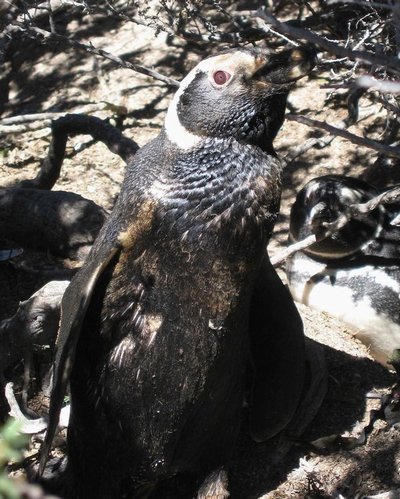January 31, 2006
Chronic oil pollution takes toll on seabirds along South American coast
The old adage tells that oil doesn’t mix with water. It doesn’t do much for creatures in the water either, as demonstrated by new research on the effects of water-borne oil on seabirds along the Atlantic Coast in Brazil, Uruguay and Argentina.
Chronic oil pollution has been a long-standing problem along a 4,200-mile stretch of coast from southern Brazil to northern Argentina. Existing laws are not solving the problem, said University of Washington biologist Dee Boersma, co-author of a paper detailing how the oil pollution is affecting Magellanic penguins, appearing in the February edition of the Marine Pollution Bulletin, published by Elsevier.
The negative effects of oil on penguins could be a barometer for less-hardy species, she said.
“There are a lot of groups rehabilitating oiled birds, some for more than two decades, and that says that for more than 20 years there’s been a big problem along this part of the South American coastline,” Boersma said. “That’s the prime wintering grounds for Magellanic penguins.”
Unlike a major oil spill that causes problems for a time and can be cleaned up, chronic oil pollution is continuous and hard to track or clean up because it comes bit by bit, sometimes in ballast water from passing ships, sometimes in seepage from offshore oil rigs.
To gauge the scope of the problem, Boersma and fellow Wildlife Conservation Society scientist Pablo García-Borboroglu of the Argentine research center Centro Nacional Patagónico assembled a team to see how many organized groups are working to save oiled seabirds along the coast from central Argentina to central Brazil. The scientists found there were 19 groups dedicated to rehabilitating oiled seabirds, three that survey beaches looking for oiled birds and four groups that do both.
Boersma said the research team expected to find only four or five groups dealing with oiled birds and was surprised to encounter so many. The groups are not evenly distributed along the coast but are clustered near ports, oil terminals and offshore oil-drilling platforms.
The scientists found that the most commonly treated living birds were Magellanic penguins, which made up nearly 64 percent of the seabirds rehabilitated by the groups from 1995 to 2005. Live oiled penguins were most common in northern Argentina and less common farther north, along the coasts of Uruguay and Brazil. That finding correlates with Argentina’s oil exportation, which grew rapidly in the 1990s.
But while oil pumping and loading take place only at specific places in northern Argentine waters, oiled penguins are found all along that coastline, leading researchers to wonder how the birds became oiled in areas where there is not petroleum activity.
Previous research estimated that 40,000 Magellanic penguins were killed by chronic oil pollution off the coast of Chubut Province in Argentina each year from 1982 to 1991. In 1994, oil tanker shipping lanes were moved 60 miles farther off the coast and few penguins are now found dead from petroleum along that coast.
But oil remains an issue because, as Boersma noted, Magellanic penguins can swim 60 miles a day and on foraging trips during breeding season they can swim hundreds of miles without coming ashore. Their physical condition can deteriorate quickly if they run afoul of oil in the water. She likened a healthy penguin that gets lightly oiled to a diver in a wet suit with just a few holes — there’s not much difficulty and the swimmer can keep going. But heavy oil ruins the bird’s insulation, like a wet suit with lots of holes, and the swimmer wants to get out of the water immediately.
“We know when penguins get heavily oiled they tend to seek the shore because that’s their thermal neutral zone,” Boersma said. “But when they are on shore they can’t feed and so they starve to death.”
Magellanic penguins are hardy creatures that can survive for as long as a month without food during courtship and egg incubation. But among long-lived seabirds such as penguins, which reach maturity late and lay small numbers of eggs, even a small decrease in adult survival can cause overall populations to decline. Northern Argentina had more oiled penguins than other areas studied, and that also was where the largest concentration of adult birds was found, which suggests that chronic oil pollution there could be reducing the adult population, Boersma said.
In addition, even a small amount of oil reduces penguins’ reproductive success. Female penguins lay two eggs per breeding season and the male and female take turns sitting on the nest while the other goes to sea foraging for small fish. A penguin that becomes oiled might not be in any condition to return to the nesting grounds to change places with its partner. The remaining adult could be forced to abandon the nest to find food.
Because the sources of chronic oil pollution are not obvious, Boersma said, the birds could be getting oiled as far as 900 miles away from their nesting grounds along the Argentine coast.
“It’s been going on for decades and it’s having a long-term negative effect on wildlife,” Boersma said. “Penguins can live a long time with oil, but that’s not true of most seabirds. Our findings appear to be just the tip of the iceberg.”
Other authors are Valeria Ruoppolo and Rudolfo Pinho da Silva of the International Fund for Animal Welfare Emergency Relief Team, Laura Reyes of Universidad Nacional de la Patagonia in Argentina, Ginger Rebstock of the UW, Karen Griot of Fundación Mar del Plata Aquarium in Argentina, Sergio Rodrigues Heredia of Fundación Mundo Marino in Argentina, and Andrea Corrado Adornes of Centro de Recuperacão de Animais Marinhos in Brazil.
The work was funded by the Wildlife Conservation Society, the Wadsworth Endowment for Conservation Science, Friends of the Penguins, Centro Nacional Patagónico and the University of Washington.
###
For more information, contact Boersma at (206) 616-2185, (206) 616-4054 or boersma@u.washington.edu

